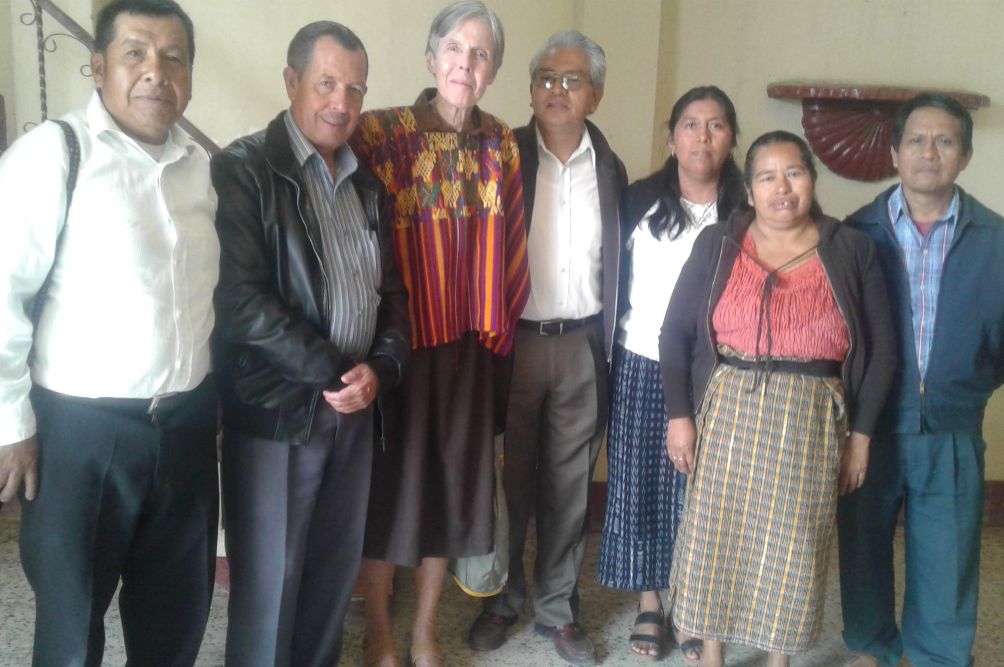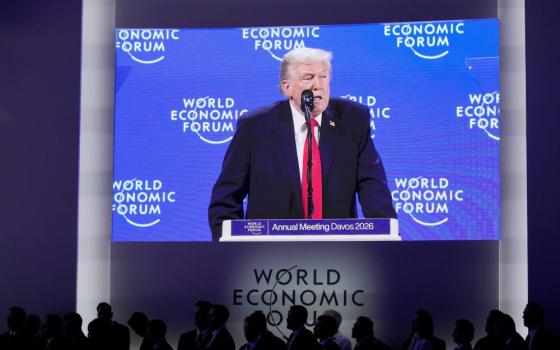
Sr. Ellen Cafferty, third from left, with lay ministers from the Carranza community in Guatemala, September 2018 (Provided photo)
Late last year, I returned to our motherhouse in San Francisco after 28 years of developing lay leadership in the parish of Jesus Nipalakin, just north of Guatemala City. The parish received its name, "Jesus walking with us," from the Kaqchikel Mayan parishioners, who make up about half of the parish population.
I carry beautiful memories of those years: the way the Kaqchikel Mayans celebrate Día de los Muertos, praying to their dead, not for them, making festive altars in their homes and welcoming visiting relatives from the cemetery with a pathway of pine needles. In church people kneel on either side of the aisle with a small woven basket before them. One of the younger members of the family recites the litany of the family saints while the family patriarch or matriarch pitches a penny into the basket at the invocation of each name. The coins are left for the parish priest, while people head back home to visit and to share a feast day dinner of tamales.
My most stark memory of those years comes from frequent bus trips to Guatemala City. Crossing one of the bridges into the capital, it is difficult not to be struck by the cardboard shacks of the mostly Mayan people that live along the ravines. In a heavy rainy season, the people and their shacks can be swept into the river below. My missionary pastor told me the Mayan people fled from their own lands into the city to escape the genocide in the countryside by the Guatemalan army. Ostensibly to rid the country of the "communist infiltrators from Cuba," 400 Mayan communities were completely obliterated after their land was found to be rich in oil and minerals.
A peace treaty ending the civil war was signed on Dec. 26, 1996, but the peace was only on paper. Too many open wounds had to be healed, the truth had to be told. Bishop Juan José Gerardi, heading the Archdiocesan Office of Human Rights, asked sisters to interview survivors of the genocide. After two years of investigation, Gerardi presented tragic accounts of murder, rape and scorching of villages. His public presentation of the findings was made in the cathedral of Guatemala City on Friday, April 24, 1998. The following Sunday, Gerardi was getting out of his car when an assassin bludgeoned him to death with a cement brick. The government made futile and ridiculous attempts to blame the assassination on a street person, but Gerardi's own Office of Human Rights received information from terrified members of the presidential palace guard that two of their own company had been sent to assassinate him. Those scapegoats were tried, convicted and sent to prison.
Assassinations, violence, deceit and other forms of corruption have crept through the country like a plague. Children and adolescents are enticed into street gangs that fight rival gangs over territory. Those who resist joining a gang or who want to leave one are murdered. One Lent, in Las Margaritas, a community of 800 families where I was living, we made the 14 Stations of the Cross at places along the streets where one of the young boys had been found shot or stabbed to death. A second exodus began as people fled the street violence; the risk of going north was not as dangerous as life in Guatemala.
Advertisement
This dire account may lead a reader to believe that Guatemala is spawning crime and criminals. It certainly has more than its share, but the greater majority of our parishioners, having witnessed the consequences of gang violence and the ubiquitous presence of the drug trade, haven't given into it. After that Lent, members of the Basic Christian Communities gathered to reflect on what they could do to make things better for their children, especially the teenagers. After much pondering and praying, they pledged to turn the local garbage dump into a sports area. Every Sunday morning for weeks, the men and boys gathered after Mass to level the land. The women held bake sales to raise funds to fence the basketball court and buy goal posts for the soccer field. For the last few years, children and teenagers have been able to participate in local soccer and basketball tournaments, their families spending Sunday afternoons cheering their favorite team.
Still, day-to-day living is a steep uphill climb. Most people have to resort to temporary jobs in the clothing factories on the outskirts of Guatemala City or work as peons in construction projects. There never seems to be enough income to pay for food and housing, plus school books, uniforms, shoes and bus fare. The daily diet, often consisting of coffee and sweet bread in the morning, tortillas and beans at midday and more coffee and bread before bed time, leaves many suffering from anemia, colds or exhaustion.
The urgency of providing a decent income for their families spurs fathers or mothers to come north to the promised land of the United States of America. They soon find that life in the U.S. is not at all a Garden of Eden. Maryknoll Sr. Nancy Donavan took me to visit one small room in a decrepit apartment building in east Los Angeles, shared by a dozen men from Huehuetenango.
People from the family-oriented Guatemalan culture find life here to be lonely and empty. So they decide to bring their families here. Some have achieved this precious goal legally, but visas are prohibitively expensive, so they resort to hiring coyotes (human smugglers) — usually more expensive than a visa — and much more dangerous. No one knows how many people have died attempting to cross Mexico's northern desert or how many women have been raped or held for ransom by their coyotes. Too many times, we have seen what it's like at the border where children are traumatized when separated from their mothers, who in turn are held as prisoners in overcrowded cells where there's hardly room to stand and where the women are unable to wash or use the toilet in private.
Too often, U.S. politicians forget that the work immigrants are doing in our country is work no one else wants to do, so their labor is very much in demand. Here in California, the immigrants stoop under the intense sun from dawn till dusk, picking strawberries, artichokes and asparagus. They pick grapes and oranges, becoming the backbone of the state's agricultural economy. In the Gulf states, they plant trees for the paper industries; in Manhattan, they clean hotel bathrooms; in Chicago restaurants, they wait tables and wash dishes.
Why can't we see that they have earned a right to be here?
On the nightly news I have heard President Donald Trump belittle immigrants, branding them as criminals and drug dealers. I would like to invite the president to Guatemala, not to the tourist spots or golf courses, but to the heart of the country where he would find hardworking, honest, family-loving people who earn their living honestly, and have supported the USA by their labor and by sharing the values of their own rich cultural heritage.
[Ellen Cafferty is a Presentation Sister from San Francisco, California. First a primary grade teacher in California, she left in 1965 for 21 years of missionary work in Chiapas, Mexico. From the Tzeltal people, she learned reverence for Mother Earth and important lessons about God and life. After a few years in family ministry, she was a missionary for 27 years in Guatemala.]




